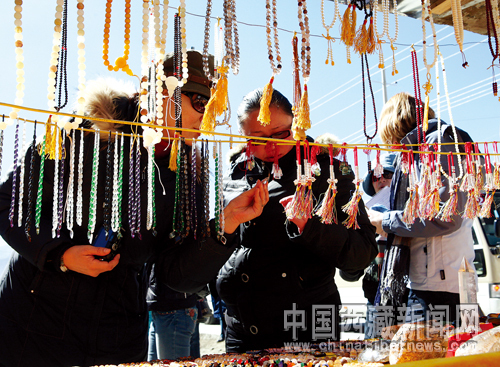Aid-Tibet tour guides: 'We're glad to serve plateau'
There are a group of people coming to Tibet from other parts of China, only to achieve a common goal to speed up Tibet's economic development and social progress. They are called "aid-Tibet officials."
|
|
|
An official from Tibet's Tourism Bureau presents Hada, a white scarf symbolizing good luck in the Tibetan language, to an aid-Tibet tour guide. [Xinhua Photo] |
Among them a group of youths display the characteristics of the snow-covered plateau with their words and deeds. They are what are known as "aid-Tibet tour guides."
In April 2009, the seventh group of aid-Tibet guides at an average age of 28.5 arrived in the region from the 16 province-level areas in China. Expert at foreign languages including English, Japanese, German, Russian, Korean, French or Italian, they are believed to have injected a fresh vigor into the regional guide market. Their professional dedication has also impressed local residents as well as tourists.
Tibet's scenic spots are 70 km to 1,000 km apart from one another. It is a hard job to work in Tibet as a tour guide. To serve as a guide for European and American tourist groups is considered undoubtedly much harder because of the longer distances and more spots.
"We almost have no break time in peak seasons. We accompany tourists by foot throughout their trips, despite strong ultraviolet on the plateau. But none of us have complained at all," said Zhang Yan, a German tour guide.
|
|
|
Visitors choose tourist souvenirs at a stall selling Tibetan handicrafts. [Photo Source: chinatibetnews.com] |
In the summer of 2009, Jiang Haoce, a Japanese tour guide from Shanghai, received another touring party after serving eight parties within five days. Unluckily, the young man caught wet lungs due to over-fatigue and was asked to be hospitalized by a doctor.
In Tibet, guides are badly-needed in such a season. Duty-bound, he chose to postpone his hospitalization before finishing the eight-day trip in order not to bring losses to his travel agency.
Appealed by his wonderful interpretation and moved by his dedication, Japanese visitors shook his hands as they said a long goodbye.
Tibet differs from inland cities in human geography. These guides make full use of their spare time to study more about the region including its history, culture, religion and folklores, in the hope of enhancing their academic background. Some even have paid closer attention to the development of Tibet's tourist market.
|
|
|
A Tibetan girl greets an aid-Tibet guide with Tibetan food chemar(a box containing Tsampa) at the Lhasa Airport. [Xinhua Photo] |
Japanese guide Wu Suhong from southwest China's Sichuan Province wrote an essay to analyze the Japanese tourist potential and propose to Chinese travel agencies on how to improve their services. Her essay is considered helpful to promoting the thriving of Tibet's tourism industry.
"I was so pleased to do such an academic research for the plateau's tourism in my free time," Wu said.
Recent years have seen increased exchanges and greater cooperation among travel agencies in Tibet and other parts of China.
According to preliminary statistics, the latest group of 35 aid-Tibet tour guides have received 4,257 visitors from 439 domestic and foreign touring parties in the past half year.
 0
0 










Go to Forum >>0 Comments